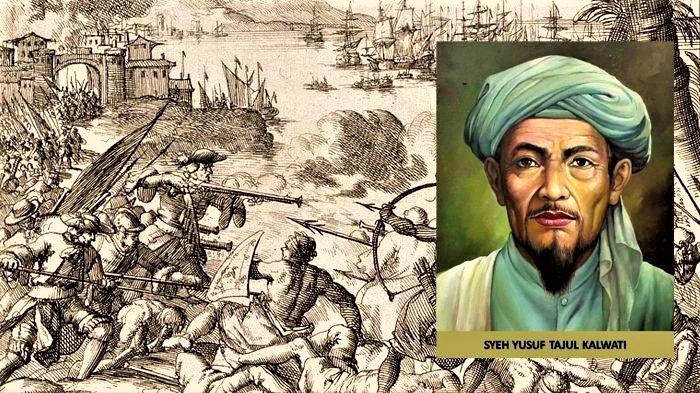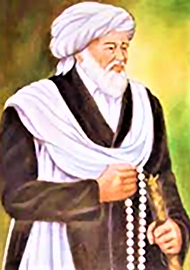The “Circle of Peace and Tranquility”: The Karamat of Abadin Tadia Tjoessoep (Part 2)
TRANSCEND MEMBERS, 15 Aug 2022
Prof Hoosen Vawda – TRANSCEND Media Service
“Peace Hunter: The Odyssey of an Exiled, Spiritual Person, Sheik Yusuf from Goa to South Africa” [i]
13 Aug 2022 – This series of publications narrate the history behind the Islamic mausoleums or Karamah in the Western Cape and Robben Island (Seal Island), South Africa, highlighting the important burial sites of Islamic, spiritual men on buried therein, over the past 300 years. Collectively, these sites form a spiritual “Circle of Peace and Tranquility”. In Part 1, the life and mausoleum Sheik Sayed Abduraghman Motura was described.[2] The present publication narrates the life of Abadin Tadia Tjoessoep, locally known as Sheikh Yusuf or Sheik Joseph, He was also known as Muhammad Yusuf al-Maqassari.[3] He was an Indonesian Muslim, born of noble descent, in 1626 in Goa in eastern India. A devout maternal nephew of King Biset of Goa, he spent years in Arabia studying under the tutelage of several pious teachers.[4] Furthermore, as nephew of the Sultan Alauddin of Gowa, in today Makassar, Indonesia. In 1693 he was exiled to the Cape of Good Hope, South Africa, which resulted in his establishing Islam in the Cape of Good Hope in the 17th century.[5] The, post liberation Africa National Congress Government of South Africa, formed in 1994, awarded and honoured Sheik Yusuf, as having made “exceptional contribution to the struggle against colonialism”.[6]
These spiritual men, most of whom were brought to South Africa, as exiles by colonial invaders of territories in the East and India, in the era of imperialism, when new colonies and spice routes were sought and fought for in bloody battles of occupation and oppression of indigenous people of the invaded land. These men have been instrumental in propagating peace and spiritually amongst the slaves and indigenous people of South Africa, bringing about some degree of relief from the physical, mental and often religious tyranny of the colonial invaders. This policy of the invaders also resulted in genocide of a cultural, religious, artistic as well as ethnicity of the indigenous populations. The advent of Christian missionaries, into the occupied territories, further compounded the brutal tyranny, by forced conversions of the local people, often under the introduction of regional inquisition, by Papal decree, in various parts of the South East Asia, as well in the Independent state of Goa, in India. This was a typical example where the Portuguese introduced the inquisition which led to the total eradication of the local language.[7] The Dutch, Portuguese, English, French, Spanish and Danish seafaring Europeans in a mad rush for dominance of Southeast Asia and its resources entered this arena not just warring against each other but also warring against the Arab merchant presence and influence. Most importantly they were at war with the indigenous peoples of the region. These wars resulted in thousands of captives some of whom were sold into slavery. Others who were royals, nobility, military leaders and religious leaders were banished to colonies or areas where European powers had established what they called “Factories headed by colonial Factors”.
Standing in opposition to the European invasion and appropriation of wealth were a number of powerful kingdoms, small empires and fiefdoms. Some of these were headed by rulers who also often were revered spiritual leaders known as the Orang Cayen. Sheikh Yusuf Al-Makassary was one of these Orang Cayen[8], translated as “Men of Repute”, also known as Tuans, or in Sulawezi, as the Wali Pitue. Sheikh Yusuf spent several years studying Arabic and traditional religious sciences in Mecca. He eventually returned to Banten, West Java, where he taught the Islamic doctrine of “Khalwatiyyah”, which he had learned during his years spent in Mecca.[9]
During the 17th century, the Eastern India, seaboard was in a state of turmoil as the Dutch and English East India Companies battled for control of the lucrative trade in spices and gold, sometimes with and at other times against the various local potentates, and when Sheikh Yusuf left Jeddah in 1664 he was unable to return home because the Dutch had captured Macassar while he was in Arabia.
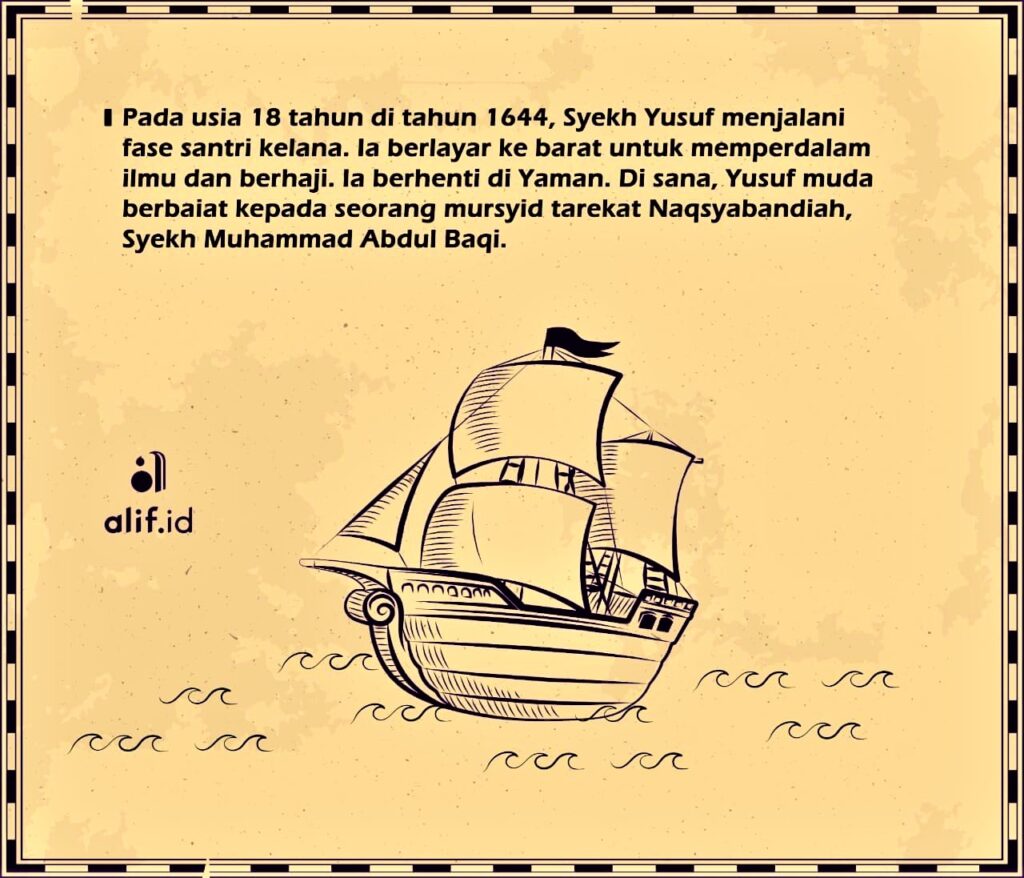
At the age of 18 in 1644, Sheikh Yusuf underwent a wanderin gor santri phase. He sailed to the west to deepen his knowledge and perform Hajj. It stopped in Yemen. There, young Yusuf pledged his allegiance to a murshid of the Naqshabandiah order, Sheikh Muhammad Abdul Baqi. (Photo credit Alif.id)
At the age of 18, instead he sailed to Banten in Western Java, where he was welcomed by the ruler, Sultan Ageng, who gave Sheikh Yusuf his daughter’s hand in marriage and made him his chief religious judge and personal advisor. Sheikh Yusuf lived in Banten for 16 years, revered throughout the East Indies for his piety and wisdom, till Sultan Ageng’s son, Pangeran Hajji, rose against his father in 1680, possibly at the urgings of the Dutch East India Company. The Dutch, like all the colonials invading foreign land used the principle of divide and rule, to eventually subjugate the local rulers and indeed the citizenry.
Sultan Ageng rallied his forces and in 1683 besieged Pangeran Hajji in his fortress at Soerdesoeang. Pangeran Hajji asked for and received Dutch military aid. Sultan Ageng was defeated but managed to escape capture, along with an entourage of about 5 000, among them the 57-year-old Sheikh Yusuf, the Sultan’s two sons, Purbaya and Kidul, and about 1 300 soldiers. In 1684 Yusuf was persuaded to surrender on the promise of a pardon, but the Dutch reneged on their promise and instead imprisoned him at the castle of Batavia. Suspecting that he would attempt escape, the Dutch transferred him to Ceylon in September that year, before exiling him to the Cape on 27th June 1693 on the ship “de Voetboeg”. Yusuf, along with 49 followers including two wives, two concubines and twelve children, were received in the Cape on 02nd April 1694 by governor Simon van der Stel.[10] They were housed on the farm Zandvliet, far outside of Cape Town, in an attempt to minimise his influence on the DEIC’s slaves.[11] The plan failed however; Yusuf’s settlement soon became a sanctuary for slaves and it was here that the first cohesive Islamic community in South Africa was established. From here the message of Islam was disseminated to the slave community of Cape Town. Sheikh Yusuf remained loyal to Sultan Ageng in the ensuing war, but was taken prisoner when the sultan was defeated. Initially he was held at Ceylon, but was a man of such influence that it was decided to exile him to a place remote from the East Indies, the small outpost at the distant Cape. Hence, Sheik Yusuf arrived in the Cape of Good Hope. This was a strategic move by the Dutch occupiers of Indonesia, to exile Sheik Yusuf, as far ways as possible, so that his immense personal influence and reputation would not be of any use in a distant colony of the Dutch invaders.
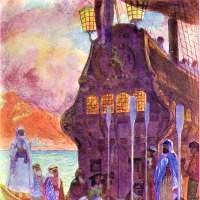
Painting of the arrival of Sheik Yusuf at the Cape of Good Hope under Dutch Control on 02nd April 1694 [12]
Sheikh Yusuf, his family and followers were sent to Zandvliet farm [13]at the mouth of the Eerste River, just outside Cape Town, to prevent his influence on the Islamic slave population. Presently, the farm is a part of the rich Cape Vinelands and is the site of production of prestigious Shiraz, South African vine. It is ironical that this farm had belonged to a minister of the Dutch Reformed Church, the Reverend Petrus Kalden. Under the leadership of Sheikh Yusuf, who was 68 years of age at the time, the group at Zandvliet established one of the first elementary structures of a Muslim community. Dutch attempts to isolate them failed as Zandvliet became a gathering spot for Muslims and a rallying point for runaway slaves, and other exiles from the East. This farm area is now known as Macassar. As Sheikh Yusuf’s influence and spiritual teachings spread widely amongst the slaves at the Cape, they came to represent one of the first areas of resistance to colonisation at the Cape.
Repeated calls from the people and the King of Goa to have Sheikh Yusuf released and sent home were refused by the Dutch. In 1698, the Batavian Council issued a definite refusal to even consider the request and a year later on 23rd May 1699, Sheikh Yusuf died. He was buried on a hill overlooking Macassar. In 1925, an architect, Mr Franklin Kaye Kendall[14] wrote on the Kramat of Sheikh Yusuf in Macassar, Western Cape, as follows:- A tomb constructed there in his memory is among the 25 Islamic shrines or kramats that encircle Cape Town. A special deputation came over from Malacca to Cape Colony to fetch away the corpse of Sheik Yusuf, for conveyance to the land of his birth, but at the disinterment it happened that the little finger of the Sheik, in spite of the most persevering research, could nowhere be found. This circumstance appeared to those simple believers’ sufficient reason for erecting a mausoleum over the spot in which the finger of a Malay Sheik lay hidden from view. Even to this day the Malays from time to time perform a pilgrimage to the shrine of Sheik Yusuf and celebrate their religious ceremonies at the Mausoleum. Four followers of the Sheik are buried with him, two of them Islamic priests, who are regarded with much veneration by the Malays.
An extensive flight of stone steps leads to the tomb, the exterior of which is very insignificant, and, but for a small pointed turret, hardly differs from an ordinary dwelling-house. On entering, a low-roofed vault is visible, a sort of front outhouse, which rather disfigures the facade, and much more resembles a cellar than the portal of a Mausoleum. Above the arch of this vault an Arabic inscription has been engraved with a stylus but this is so painted over in brick colour that it has already become almost illegible. Judging by the few words that have been deciphered, it seems to consist of the first propositions of the Quran.
The inner room, provided on two sides with modern glazed windows at irregular intervals, is about the size of an ordinary room of 3.66m long, 2.74 wide, and 2.13 high. In the middle rises the monument, to which access is had by some more brick steps. Immense quantities of unwashed white linen cloth are heaped upon it, which seem occasionally sprinkled with a brown odoriferous liquid (dupa). As at the head of Sheikh Yusuf’s tomb and also at the feet end, several figures, resembling those in enamel used to ornament tarts, are drawn upon the linen cloth with the overflowings of the unguent. These have undoubtedly been formed accidentally, and it appears wrong and unfair to attribute to them any more recondite significance. The monument rests upon four wooden pillars, with pyramidal pinnacles or ornaments, and is richly decorated with fine white muslin, which gives to the whole very much the appearance of an old-fashioned English “fourposter,” with its costly drapery and curtains. While the curtains are spread out all around, several small green and white bannerets stand at the upper and lower end of the sarcophagus. The whole interior is, as it were, impregnated with the incense which devout Malay pilgrims from time to time burn here, especially after the thirty days’ fast of Ramadan, or leave behind upon the steps of the tomb in flasks or in paper-boxes. On such occasions, they always bring wax-candles and linen cloth as an offering, with the latter of which they deck the tomb afresh, so that a perfect mountain of white linen rises above the stone floor. During their devotions they unceasingly kiss this white mass of stuff, and as they are continually chewing tobacco, this habit produces disgustingly loathsome stains, in the past
On the same hill which houses the tomb of Sheikh Yusuf, there are also, in ground that is common property, nine other graves of eminent Malays, enclosed with carefully-selected stones, and likewise covered over with large broad strips of bleached linen cloth, protected by stones from any injury by weather or violence. At the head and foot of each individual interred, is a single stone of larger size. Formerly the black inhabitants of the neighbourhood made use of this store of linen cloth to make shirts for themselves, without further thought upon the propriety of the matter. Latterly, however, a wise Malay priest spread a report that one of these ebony linen stealers had lost all the fingers off one hand, since which the graves of those departed worthies remain inviolate and unprofaned.[15]
At the foot of the hill are some small half-fallen-in buildings, near a large hall, painted white, red, and yellow, consisting of a small apartment and a kitchen, the whole in a most, neglected, and desolate condition. At this point the Muslim devotees accomplished certain prayers, before they can climb the hill and proceed to visit the tomb. Over the door of this singular house of prayer some words are likewise engraved in the Arabic calligraphy, which, however, are now entirely illegible.
From the Krammat, there is a difficult walk to the sand-dunes, which at this point extend along the entire coast line, on which the wax-berry shrub, grows wild, in vast quantities and visibly prevents the further encroachments of the moving sand. The Eerst Rivier, translated the First River may be regarded as the limit of demarcation between the sand-dunes and the soil adapted for vegetation.”[16]
In 1925 with the full sponsorship of an Indian philanthropist,, Hadji Sulaiman Shah Mohamed Ali, a new mausoleum was constructed along the lines of such structures built by Akbar the Great in India, the Moghul Emperor based in Delhi. The architect for the new project was F.K. KENDALL which took from 1896 to 1918 , when it was completed by Herbert BAKER.[17]
The following is the text on the Minaret, adjoining the tomb:
IN MEMORY OF
SHEIKH YUSUF
MARTYR & HERO
OF BANTAM
1629 – 1699
THIS MINARET
WAS ERECTED BY
HAJEE SULLAIMAN
SHAHMAHOMED
IN THE REIGN OF
KING GEORGE V
MAY 1925
_____________________
THIS MEMORIAL WAS UNVEILED
19TH DECEMBER 1925 BY
SIR FREDERIC DE WAAL
KCMG:LLD:FIRST ADMINISTRATOR
OF THE CAPE PROVINCE
IN THE YEAR WHEN THIS
DISTRICT WAS VISITED BY
HIS ROYAL HIGHNESS
THE PRINCE OF WALES
4TH MAY 1925
THE “DARGAN” OF ASHBAT
[COMPANIONS] OF SAINT SHEIKH YUSSUF
[GALERAN TUANSE] OF MACASSAR.
HERE LIE THE REMAINS OF FOUR OF FORTY-NINE
FAITHFUL FOLLOWERS WHO AFTER SERVING
IN THE BANTAM WAR OF 1682-83, ARRIVED WITH
SHEIKH YUSSUF AT THE CAPE FROM CEYLON,
IN THE SHIP “VOETBOOG” IN THE YEAR 1694.
_____
THIS COMMEMORATION TABLET WAS ERECTED
DURING THE GREAT WAR ON 8 JANUARY 1918.
BY HAJEE SULLAIMAN SHAHMAHOMED.
SENIOR TRUSTEE.
Wording on plaque:
PRESIDENT SOEHARTO
OF THE REPUBLIC OF INDONESIA
VISITED THIS SHRINE ON 21 NOVEMBER 1997
TO PAY RESPECT TO THE LATE SHEIKH YUSSUF OF
MACASSAR UPON WHOM THE TITLE OF NATIONAL
HERO WAS CONFERRED BY THE INDONESIAN GOVERNMENT
ON 7 AUGUST 1995
Sheikh Yusuf’s remains were brought to Makassar (Ujung Pandang of present day) in 1705 and interred in a tomb located in Katangka Village, bordering on the Goa regency. The teachings of Sheik Yusuf established a sound Muslim community at the Cape. His insightful approach and understanding of the religion still continues today.[18]
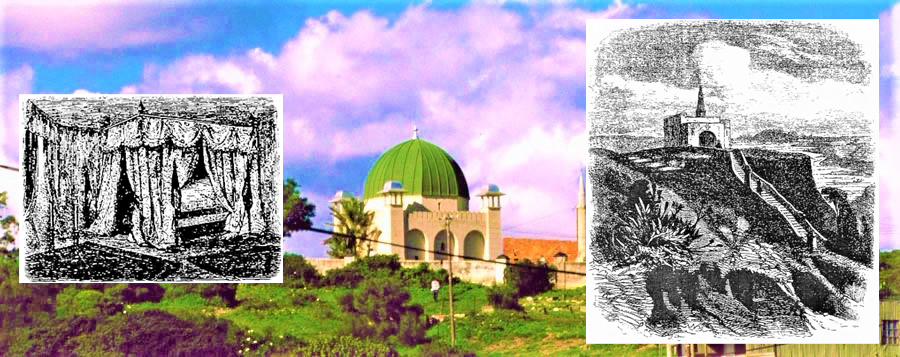
Present day view of the Karamat or Mausoleum of Sheik Yusuf in Macassar near the beach, Western Cape.
Sheikh Yusuf’s remains were brought to Makassar (Ujung Pandang of today) in 1705 and interred in a tomb located in Katangka Village, bordering on the Goa regency.
Inset Illustrations: Left: Interior of Karamat after Scherzer, 1861, p. 247, a canopy was constructed, where the little finger of the Sheik was lost during the exhumation in 1703, Right: The original Karamat with hundred steps.[19]
The Bottom Line is that the Circle of Peace is formed by the geographical location of the graves of pious and peace-loving protagonists who were brought to South Africa under the colonial occupation by the Dutch from their birthplaces in western India as well as South East Asia and include up to 25 different “Men of Repute”. Each spiritually enlightened person of repute, has contributed to the character of the indigenous people of the regions as well as influenced their lifestyles, food, culture, religion, languages, traditions and contributed to the cosmopolitan flavours of general culture in the Western Cape as well as the rest of South Africa. These men of repute led by example and not by dictates. In this manner, they achieved a holistic level of respect which was earned rather than being bestowed upon them by the indigenous people.
It is necessary to mention, that when the author visited the mausoleum of Sheik Yousuf in Macassar, he felt a state of calmness and inner peace. The sanctity of the Mausoleum, as well as the surroundings, was most evident and a profound feeling of inner peace prevailed. The entire experience was an immersive one, whereby, the concept of time was meaningless as the gentle ocean breeze seems to whisper peace all around the spiritual precincts. Noting that the mortal remains of Sheik Yusuf had been exhumed and repatriated to his birthplace, nearly, four years following the demise of the great Sheik. Although there were already some Muslims at the Cape before the arrival of Yusuf, he is regarded as the founder of the Islamic faith at the Cape. The Muslim community, to whom he had provided guidance, faith and hope, flourishes in South Africa today. He legacy of Sheik Yusuf is extremely important. Although there were already some Muslims at the Cape before the arrival of Yusuf, he is regarded as the founder of the Islamic faith at the Cape. The Muslim community, to whom he had provided guidance, faith and hope, in addition the Islamic religion, under the propagation of Sheik Yusuf, flourishes in South Africa, today.[20]
References:
[i] Personal quote by author August 2022
[1] https://en.wikipedia.org/wiki/1740_Batavia_massacre
[2] https://www.transcend.org/tms/2022/08/the-circle-of-peace-and-tranquility-the-karamat-of-sheik-sayed-abduraghman-motura-part-1/
[3] http://www.e-family.co.za/ffy/g5/p5815.htm#c5815.1
[4] https://www.thepresidency.gov.za/national-orders/recipient/sheik-yusuf-1626-1699
[5] https://web.archive.org/web/20101022091540/http://www.sahistory.org.za/pages/library-resources/online%20books/history-muslims/1600s.htm
[6] https://www.thepresidency.gov.za/national-orders/recipient/sheik-yusuf-1626-1699#:~:text=Exceptional%20contribution%20to%20the%20struggle%20against%20colonialism.
[7] https://www.transcend.org/tms/2022/05/peace-are-religions-the-cause-of-peace-disruption-in-humanoids-part-3/
[8] https://www.sahistory.org.za/article/cape-malay#:~:text=Orang%20Cayen%20%2D%20Men%20of%20Repute
[9] https://www.sahistory.org.za/article/cape-malay#:~:text=Sheikh%20Yusuf%20spent%20several%20years%20studying%20Arabic%20and%20traditional%20religious%20sciences%20in%20Mecca.%20He%20eventually%20returned%20to%20Banten%2C%20West%20Java%2C%20where%20he%20taught%20the%20Islamic%20doctrine%20of%20%22Khalwatiyyah%22%2C%20which%20he%20had%20learned%20during%20his%20years%20spent%20in%20Mecca.
[10] http://www.e-family.co.za/ffy/g5/p5815.htm#c5815.1
[11] https://web.archive.org/web/20101022091540/http://www.sahistory.org.za/pages/library-resources/online%20books/history-muslims/1600s.htm
[12] https://www.sahistory.org.za/dated-event/sheik-yusuf-arrives-cape-good-hope
[13] https://www.bing.com/ck/a?!&&p=acd7fab2c80fde5fJmltdHM9MTY2MDM2NTUxNCZpZ3VpZD1jNzZkOGUxMi1mYWMwLTQ4YTItYTUzNy04Yzk3M2RhNjMyNzgmaW5zaWQ9NTE1NA&ptn=3&hsh=3&fclid=ca562f2b-1ac1-11ed-aceb-c45509cf083a&u=a1aHR0cHM6Ly96YW5kdmxpZXQuY28uemEv&ntb=1
[14] http://www.artefacts.co.za/main/Buildings/archframes.php?archid=879
[15] http://www.artefacts.co.za/main/Buildings/bldgframes.php?bldgid=10977#:~:text=Wording%20on%20Minaret,7%20AUGUST%201995
[16] http://www.artefacts.co.za/main/Buildings/books.php?bookid=1248
[17] http://www.artefacts.co.za/main/Buildings/bldgframes.php?bldgid=10977#:~:text=Schalk%20W%20le%20Roux%2C%20Gordonsbaai%2C%20Februarie%202013
[18] https://www.family.faure.co.za/tng/showmedia.php?mediaID=165
[19] http://www.artefacts.co.za/main/Buildings/bldgframes.php?bldgid=10977#:~:text=Scherzer%2C%20K.%201861.%20Narrative%20of%20the%20circumnavigation%20of%20the%20globe%20by%20the%20Austrian%20frigate%20Novara%2C%20(commodore%20b.%20Von%20Wullerstorf%2DUrbair%2C)%3A%20undertaken%20by%20order%20of%20the%20imperial%20government%2C%20in%20the%20years%20l857%2C1858%2C%20%26%201859.%20London%3A%20Saunders%2C%20Otley%20%26%20Co%2C%20pp.%20244%2D248.
[20] https://www.sahistory.org.za/dated-event/sheik-yusuf-arrives-cape-good-hope#:~:text=Potgieter%2C%20D.J.%20et%20al.%20(eds)(1970).%20Standard%20Encyclopaedia%20of%20Southern%20Africa%2C%20Cape%20Town%3A%20NASOU%2C%20v.%2011%2C%20p.%20567.%7CSAHO%2C
______________________________________________
 Professor G. Hoosen M. Vawda (Bsc; MBChB; PhD.Wits) is a member of the TRANSCEND Network for Peace Development Environment.
Professor G. Hoosen M. Vawda (Bsc; MBChB; PhD.Wits) is a member of the TRANSCEND Network for Peace Development Environment.
Director: Glastonbury Medical Research Centre; Community Health and Indigent Programme Services; Body Donor Foundation SA.
Principal Investigator: Multinational Clinical Trials
Consultant: Medical and General Research Ethics; Internal Medicine and Clinical Psychiatry:UKZN, Nelson R. Mandela School of Medicine
Executive Member: Inter Religious Council KZN SA
Public Liaison: Medical Misadventures
Activism: Justice for All
Email: vawda@ukzn.ac.za
Tags: History, India, Islam
This article originally appeared on Transcend Media Service (TMS) on 15 Aug 2022.
Anticopyright: Editorials and articles originated on TMS may be freely reprinted, disseminated, translated and used as background material, provided an acknowledgement and link to the source, TMS: The “Circle of Peace and Tranquility”: The Karamat of Abadin Tadia Tjoessoep (Part 2), is included. Thank you.
If you enjoyed this article, please donate to TMS to join the growing list of TMS Supporters.

This work is licensed under a CC BY-NC 4.0 License.
